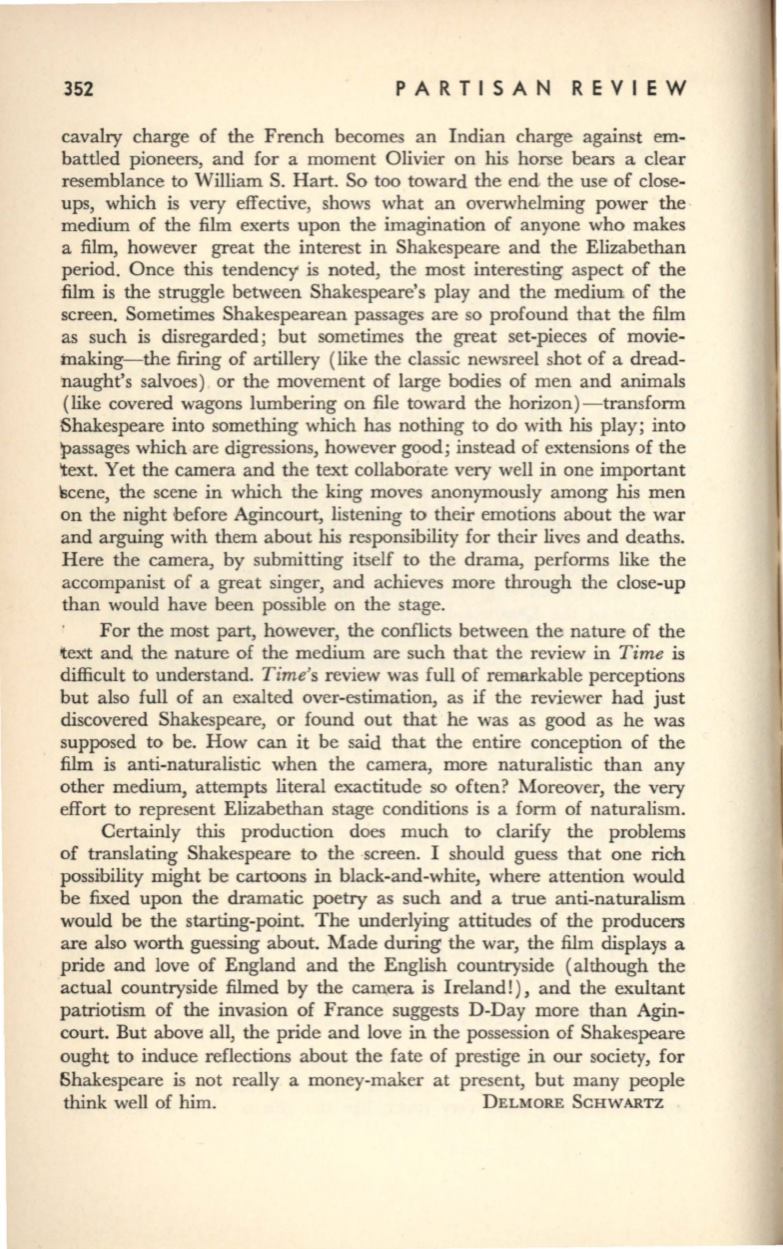
352
PARTISAN REVIEW
cavalry charge of the French becomes an Indian charge against em–
battled pioneers, and for a moment Olivier on his horse bears a clear
resemblance to William S. Hart. So too toward the end the use of close–
ups, which is very effective, shows what an overwhelming power the ·
medium of the film exerts upon the imagination of anyone who makes
a film, however great the interest in Shakespeare and the Elizabethan
period. Once this tendency is noted, the most interesting aspect of the
film is the struggle between Shakespeare's play and the medium of the
screen. Sometimes Shakespearean passages are so profound that the film
as such is disregarded; but sometimes the great set-pieces of movie–
making-the firing of artillery (like the classic newsreel shot of a dread–
naught's salvoes) . or the movement of large bodies of men and animals
(like covered wagons lumbering on file toward the horizon) -transform
Shakespeare into something which has nothing to do with his play; into
passages which are digressions, however good; instead of extensions of the
'text. Yet the camera and the text collaborate very well in one important
'scene, the scene in which the king moves anonymously among his men
on the night before Agincourt, listening to their emotions about the war
and arguing with them about
his
responsibility for their lives and deaths.
Here the camera, by submitting itself to the drama, performs like the
accompanist of a great singer, and achieves more through the close-up
than would have been possible on the stage.
For the most part, however, the conflicts between the nature of the
!text and the nature of the medium are such that the review in
Time
is
difficult to understand.
Time's
review was full of remarkable perceptions
but also full of an exalted over-estimation, as if the reviewer had just
discovered Shakespeare, or found out that he was as good as he was
supposed to be. How can it be said that the entire conception of the
film
is anti-naturalistic when the camera, more naturalistic than any
other medium, attempts literal exactitude so often? Moreover, the very
effort to represent Elizabethan stage conditions is a form of naturalism.
Certainly this production does much to clarify the problems
of translating Shakespeare to the -screen. I should guess that one rich
possi:bility might be cartoons in black-and-white, where attention would
be fixed upon the dramatic poetry as such and a true anti-naturalism
would be the starting-point. The underlying attitudes of the producers
are also worth guessing about. Made during the war, the film displays a
pride and love of England and the English countryside (although the
actual countryside filmed by the camera is Ireland!), and the exultant
patriotism of the invasion of France suggests D-Day more than Agin–
court. But above all, the pride and love in the possession of Shakespeare
ought to induce reflections about the fate of prestige
in
our society, for
Shakespeare is not really a money-maker at present, but many people
think well of him.
DELMORE SCHWARTZ


